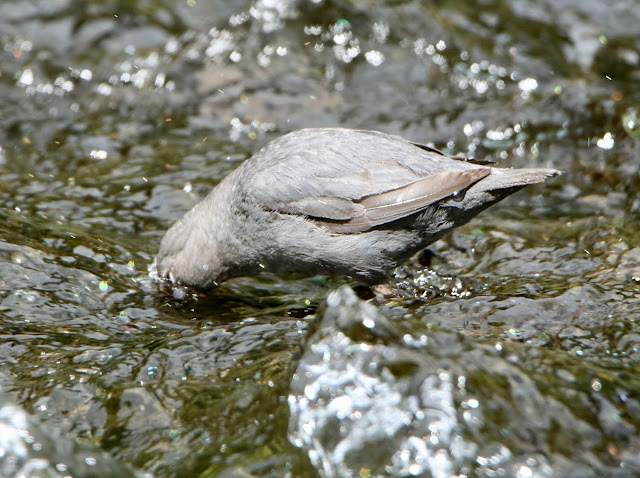A couple days before I left on the Wasco jaunt, I returned south with a birder friend and his 2 sons who are in college, but now on break, one of which is a birder. This time we were able to view both the male and the female, and below is the female.
 |
| This is where the expression, "By the scruff of the neck,'came from. |
6/24/19
I went up to the Mt Hood area with the same people who I went with to see the Spotted Owls, as we were wanting to work on our County list there. Mountain Bluebirds are one of my favorite species, but it is hard to get good photos. Their color is the same as the sky, so you really need a dark background to bring that color out. Here are 2 shots for comparison of such.
 |
| Male Wester Tanager |
 |
| Male Mountain Bluebird. Isn't he a beauty! Too bad he was looking the other way. |
 |
| The same male Mountain Bluebird. |
Yep, we do have raccoons in Oregon. These 4 youngsters may look cute, but they can really eat lots of cat food, and can be quite ferocious.
 |
| Raccoons |
 |
| One of the local squirrels |
 |
| Baby Mallard |
 |
| Virginia Rail |
7/2/19
It was going to be a cloudy, cool day, so as my home projects are on hold, I headed to Luckiamute Landing, along the Willamette River to look and listen for Red-eyed Vireos. This is the only place in the county where they breed, and I was not disappointed. There was one calling incessantly. However, he stayed high up in the cottonwood trees. I did try my hand at photographing Cedar Waxwings in flight as there were plenty of them fly catching over the river. Out of some 125 pics, these are my best two. It is hard enough just to get one in the frame let along for one to come out good.
 |
| Cedar Waxwing |
 |
| Cedar Waxwing |
 |
| Cedar Waxwing |
 |
| Downy Woodpecker |
7/8/19
Don and I went south a couple of counties to work on our Lane County lists. We did OK. This first pic is an immature Blue-gray Gnatcatcher and represents the most northerly nesting on the west side of the Cascades. The pic below is one of my favorite birds: Lazuli Bunting. The sun made for an overexposed pic and it is also a little fuzzy, but still gives and idea of how beautiful some birds are.
 |
| Immature male Blue-gray Gnatcatcher |
 |
| Male Lazuli Bunting |
7/10/19
Back where I took some pics of the waxwings was a report of a rare Bank Swallow, so I thought I'd go over there in the slim chance it might still be around. I did not refind it, so parked myself where I could take more waxwing pics, so here are the best 2.
 |
| Cedar Waxwing |
 |
| Cedar Waxwing |
7/10/19
Here is a picture a friend took of a Gray Fox. They are probably considered rare here in Western Oregon, and most likely due to the proliferation of Coyotes, which means plenty of competition for food.
7/17/19
Once again, I accompanied Don Berg and his 2 sons birding. He was wanting to work on his Deschutes and Jefferson Counties, so we took the jaunt over to the east slope of the Cascades, a straight drive east, taking 2 hours. It turned out that the wind was a factor in diminishing our success. Birds just don’t like 20 MPH winds. But we managed to see a some and so Don got off to a start for those counties. His son Jonathan is really into birding and needed a few lifers, all woodpeckers, and we were able to find 2 of them - White-headed and Black-backed. I got a reasonable pic of the White-headed.
One place we stopped was the Wizard Falls Fish Hatchery. The river here is cold and clear, and there were 2 American Dippers, an adult and juvenile. I got carried away taking pics as one allowed fairly close approach. These are one of the most amazing birds! They live along these fast flowing waterways in the mountains of the west. Their food items are all taken out of the water. Sometimes the dive down some 20 feet below the surface to find such. One food item is the caddis fly larvae. These larvae build an encasing around themselves of tiny stones with a hole at one end. When a dipper gets one, he will smash this casing enough to extract the larvae. Here are my best shots.
 |
White-headed Woodpecker. His white head is discolored
to sooty as he has been feeding in a burn area |
 |
| Townsends Solitare |
 |
| Belted Kingfisher |
 |
| He has some grub |
 |
Here's Junior. You can tell he is young because of the light
colored bill and his tail is not quite formed fully |
 |
| Metolius River next to fish hatchery |
 |
| Fishing the Metolius. You can see a dipper (barely) just upriver from this man |
sdfasdfasdf





























No comments:
Post a Comment